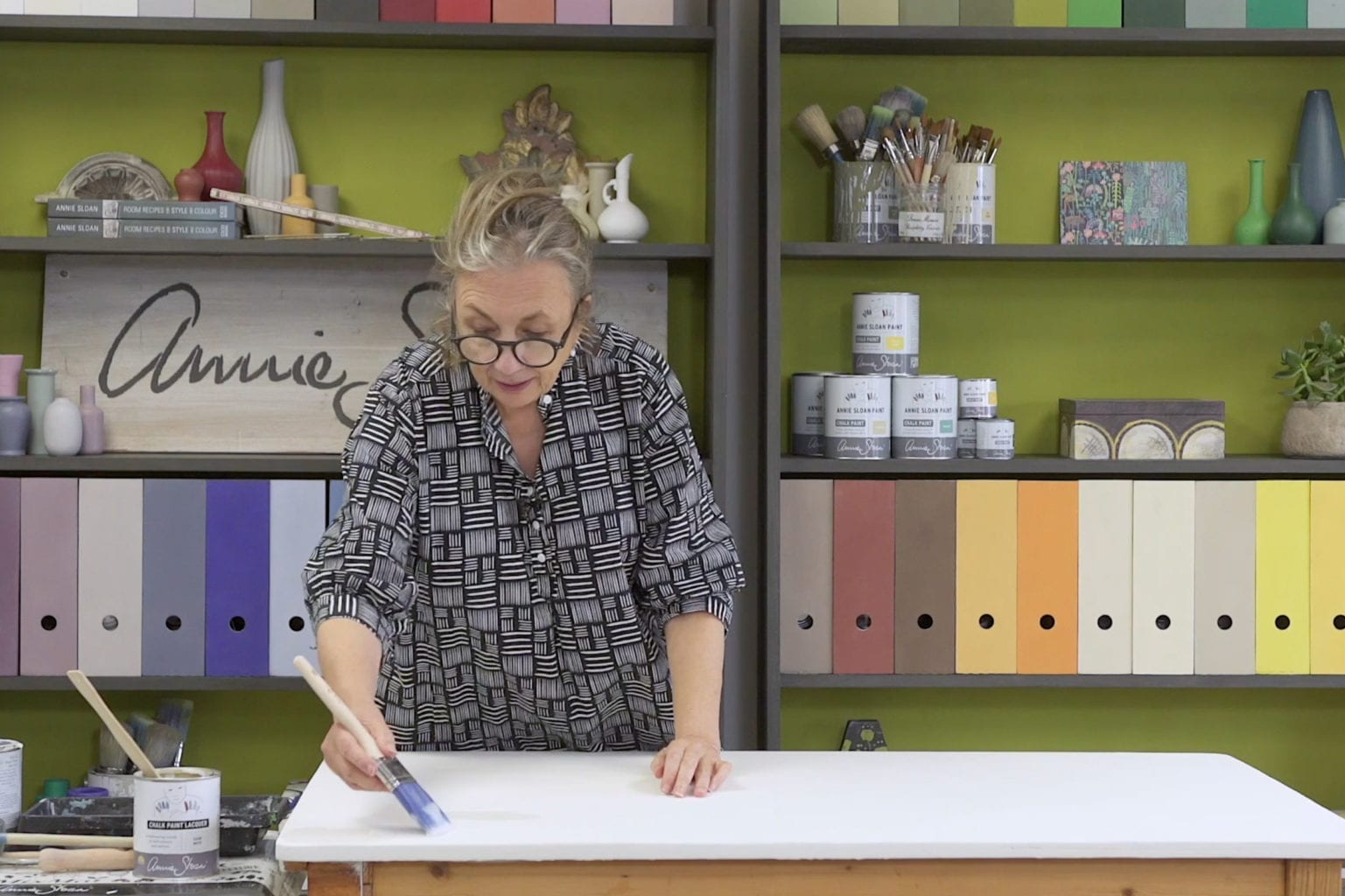Na początku Annie i Ron pomalowali natryskowo szafkę za pomocą pokazanej tu farby Chalk Paint™.
Będziesz potrzebować:
• Lakier Chalk Paint™
• Wodę
• Pistolet malarski (Tutaj Annie stosuje pistolet malarski typu HVLP (duża objętość, niskociśnieniowy) marki Wagner 2370386 Studio Home Décor Sprayer do malowania ścian wewnętrznych. W Polsce można znaleźć pistolet malarski typu Wagner w590 lub w890.)
• Maskę ochronną do twarzy
Aby uzyskać pełną instrukcję dotyczącą ustawienia pistoletu i sposobu natryskiwania farby Chalk Paint™, kliknij tutaj.
Jak nakładać natryskowo lakier Chalk Paint™
1. Zacznij od wymieszania lakieru Chalk Paint™ , aby rozprowadzić wszystkie jego składniki.
2. Napełnij zbiornik pistoletu malarskiego lakierem Chalk Paint™ mniej więcej do połowy (w wersji matowej lub z połyskiem, wybór należy do ciebie).
Przed nakładaniem natryskowym lakier Chalk Paint™ należy nieco rozcieńczyć. Nie zalecamy rozcieńczania lakieru podczas nakładania pędzlem lub wałkiem, ponieważ może to zmienić wykończenie, ale jest to niezbędne podczas natryskiwania w celu uzyskania równomiernej warstwy. Lakier Chalk Paint™ jest na bazie wody, dlatego zawsze rozcieńczaj go wodą.
3. Dodawaj wodę małymi porcjami, dokładnie mieszając między kolejnymi dolewkami, aby lakier w pełni wymieszał się z wodą i aby nie rozcieńczyć lakieru zbyt szybko.
Aby sprawdzić konsystencję, wyjmij mieszadło i przyjrzyj się pozostałościom ściekającego lakieru. Jeśli pozostawia on na powierzchni trójwymiarowy ślad, wyglądający jak smużki, oznacza to, że jest zbyt gęsty. Dodawaj wodę tak długo, aż na powierzchni nie będzie widać żadnych smużek. Należy dodać tylko tyle wody, ile potrzeba do pozbycia się tych smużek.
4. Kiedy mieszanka osiągnie odpowiednią konsystencję i zostanie dokładnie wymieszana, należy ustawić pistolet i podłączyć turbinę. Aby uzyskać więcej informacji na ten temat, przejdź do „Jak malować natryskowo farbą Chalk Paint™ część 1” tutaj.
5. Załóż na twarz maskę ochronną. Ważne, aby nosić ją przez cały czas podczas natryskiwania farby lub lakieru w jakiejkolwiek postaci.
6. Zalecamy, aby zawsze wypróbować lakier i pistolet do malowania natryskowego przed lakierowaniem mebla. Tutaj Ron wypróbował go na ścianie w studio. Stosuje on ustawienie nr 1 na pierścieniu nastawczym strumienia natrysku lakieru.
Nasza rada: jeśli turbina będzie rozgrzana, lakier będzie się lepiej nakładał. Ron zaleca, aby turbina była włączona przez około 5 minut przed rozpoczęciem nakładania. Zorientujesz się, kiedy będzie rozgrzana, ponieważ dysza wylotowa będzie gorąca w dotyku.
7. Kiedy uznasz, że konsystencja lakieru jest odpowiednia, możesz rozpocząć lakierowanie natryskowe mebla. Na tym nagraniu Annie i Ron lakierują szafkę kuchenną, którą poprzednio malowali natryskowo farbą Chalk Paint™ w kolorze Napoleonic Blue (możesz obejrzeć przebieg tego malowania tutaj). Zanim mebel zostanie polakierowany, należy naprawdę ostrożnie obchodzić się z farbą Chalk Paint™, nałożoną natryskowo. Jakiekolwiek dotknięcie farby Chalk Paint™ lub jej uszkodzenie będzie widać dwukrotnie bardziej po nałożeniu lakieru.
8. Zacznij od spryskania najpierw krawędzi i bardziej skomplikowanych elementów mebla. Następnie nakładaj lakier w uporządkowanych liniach, do połowy każdej poprzedniej linii, aby zapewnić pełne pokrycie powierzchni.
9. Stosuj konsekwentnie tę samą metodę natryskowego nakładania lakieru Chalk Paint™ . Zachowaj to samo ustawienie nakładki podczas natryskiwania, ponieważ każda zmiana pokrycia może spowodować, że lakier będzie wysychał nierówno.
10. Po zakończeniu, pozostaw pracę na około 30-60 minut w celu wyschnięcia, a następnie nałóż drugą warstwę w ten sam sposób.
11. Gotowe! Szafka kuchenna pomalowana natryskowo farbą Chalk Paint™ i polakierowana.


